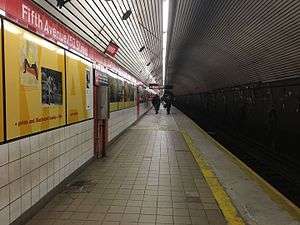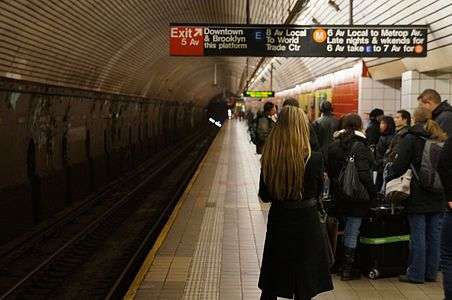Fifth Avenue/53rd Street (IND Queens Boulevard Line)
5 Avenue/53 Street | |||||||||
|---|---|---|---|---|---|---|---|---|---|
|
| |||||||||
 Upper level platform | |||||||||
| Station statistics | |||||||||
| Address |
Fifth Avenue & 53rd Street New York, NY 10019 | ||||||||
| Borough | Manhattan | ||||||||
| Locale | Midtown Manhattan | ||||||||
| Coordinates | 40°45′37″N 73°58′33″W / 40.760326°N 73.975754°WCoordinates: 40°45′37″N 73°58′33″W / 40.760326°N 73.975754°W | ||||||||
| Division | B (IND) | ||||||||
| Line | IND Queens Boulevard Line | ||||||||
| Services |
E M | ||||||||
| Transit connections |
| ||||||||
| Structure | Underground | ||||||||
| Levels | 2 | ||||||||
| Platforms | 2 side platforms (1 on each level) | ||||||||
| Tracks | 2 (1 on each level) | ||||||||
| Other information | |||||||||
| Opened | August 19, 1933 | ||||||||
| Station code | 276[1] | ||||||||
| Accessibility | Same-platform wheelchair transfer available | ||||||||
| Wireless service |
| ||||||||
| Traffic | |||||||||
| Passengers (2017) |
7,111,270[3] | ||||||||
| Rank | 56 out of 425 | ||||||||
| Station succession | |||||||||
| Next east |
Lexington Avenue–53rd Street: E | ||||||||
| Next west |
Seventh Avenue (8th Avenue): E 47th–50th Streets–Rockefeller Center (6th Avenue): M | ||||||||
| |||||||||
| |||||||||
| |||||||||
Fifth Avenue/53rd Street is a station on the IND Queens Boulevard Line of the New York City Subway. Located at the intersection of Fifth Avenue and 53rd Street in Manhattan, it is served by the E train at all times and the M train weekdays except late nights.
Fifth Avenue/53rd Street was opened in 1933 as part of the Independent Subway System (IND)'s Queens Boulevard Line. It contains two side platforms on separate levels: southbound trains to Lower Manhattan use the upper level, while northbound trains to Queens use the lower level.
History
This station opened on August 19, 1933 with the opening of the IND Queens Boulevard Line to Roosevelt Avenue in Queens. Service was initially provided by E trains running via the IND Eighth Avenue Line.[4] On December 15, 1940, the IND Sixth Avenue Line opened between West Fourth Street–Washington Square and 59th Street–Columbus Circle. On this date, F trains began using this station, diverging west of the station onto the Sixth Avenue Line.[5][6][7]
In 1959, a project started to replace the four two-feet wide escalators with new wider four-feet wide escalators–two at the Madison Avenue end of the station, and two at the Fifth Avenue end.[8] The new 94-foot long escalators were intended to increase capacity, and could run at speeds of 90 or 120 feet per minute. On September 8, 1959, the first of the four new four-feet wide escalators was put into place at the Madison Avenue entrance and replaced a two-feet wide escalator. The entire project cost $1,200,000. As part of the project, the lighting at the station was replaced with fluorescent lighting and the stairways at the station were moved.[9]
In 1981, the Metropolitan Transportation Authority (MTA) listed the station among the 69 most deteriorated stations in the subway system.[10]
Station layout
| G | Street Level | Exit/Entrance |
| B1 | Mezzanine | Fare control, station agent |
| B2 | Southbound | ← ← |
| Side platform, doors will open on the left | ||
| B3 | Northbound | → → |
| Side platform, doors will open on the right | ||
This underground station has two levels, with the upper level serving trains bound for Lower Manhattan and the lower level serving trains bound for Queens. Each level has one track and one side platform.[11] The upper level, built in a tube design, is 59 feet below street level[9] while the lower level is 80 feet below. Staircases connect each level at either ends.[12][13]
There is a junction west of this station that is controlled by a tower on the south end of the upper level platform. E trains continue west along 53rd Street while M trains turn south and enter the IND Sixth Avenue Line.[11]
In 1996, Ralph Fasanella's 1950 painting "Subway Riders" was installed. It is one of the few oil paintings in the world permanently on view in a public transportation center. It is located outside fare control in the full-time mezzanine.[14][15]
Exits
The station has two entrances/exits. The full-time exit at Fifth Avenue is at the west (railroad south) end. Two 94-foot long escalators[16] and one staircase goes up to a turnstile bank, where a token booth is present. A passageway leads to two staircases going up to either eastern corner of Fifth Avenue and 53rd Street. There is another staircase that leads to the underground shopping arcade of 666 Fifth Avenue, which has an entrance/exit on the south side of 53rd Street west of Fifth Avenue.[17][18][19]
The part-time entrance/exit leads to Madison Avenue and is located at the east (railroad north) end of the station. This exit has a turnstile bank, customer assistance booth, and two staircases, both of which are built within underground shopping arcades, going up to either eastern corner of Madison Avenue and 53rd Street.[17][20] Two 94-foot long escalators connect the upper-level platform and the mezzanine.[21]
This exit is only open on weekdays and Saturdays until 9:45 p.m..[22] The street-level gates to the station were owned by private companies who formerly closed them at 9 p.m. However, MTA workers did not close the platform-level gates until 10 p.m. During the hour in between the two gates' closures, exiting passengers often became trapped after passing through the turnstiles, forcing them to go back into the subway–either paying another fare or jumping the turnstiles. After the MTA was informed of the issue in 2013, it arranged the building owners to keep the exit open until 9:45 p.m. and the signs in the station were updated accordingly.[23]
Notable places nearby
- Austrian Cultural Forum New York[17]
- Fifth Avenue Presbyterian Church[17]
- Friars Club[17]
- Hotel Elysée[17]
- La Grenouille[17]
- Lever House[17]
- Museum of Modern Art[17]
- Paley Center for Media[17]
- Peninsula Hotel[17]
- Racquet and Tennis Club[17]
- Sony Building[17]
- St. Patrick’s Cathedral[17]
- St. Regis Hotel[17]
- Trump Tower[17]
Image gallery
 Long stairway and escalators between fare control mezzanine and upper level platform
Long stairway and escalators between fare control mezzanine and upper level platform People await the arrival of the Holiday Nostalgia Train on the upper level platform
People await the arrival of the Holiday Nostalgia Train on the upper level platform
References
- ↑ "Station Developers' Information". Metropolitan Transportation Authority. Retrieved June 13, 2017.
- ↑ "NYC Subway Wireless – Active Stations". Transit Wireless Wifi. Retrieved May 18, 2016.
- ↑ "Facts and Figures: Annual Subway Ridership 2012–2017". Metropolitan Transportation Authority. July 12, 2018. Retrieved July 12, 2018.
- ↑
- "TWO SUBWAY UNITS OPEN AT MIDNIGHT; Links in City-Owned System in Queens and Brooklyn to Have 15 Stations" (PDF). The New York Times. August 18, 1933. Retrieved November 7, 2015.
- "New Queens Subway Service Will Be Launched Tonight; Tunnel From Manhattan Open to Jackson Heights; Service Will Eventually Be Extended Through To Jamaica" (PDF). Long Island Daily Press. Fultonhistory.com. August 18, 1933. p. 20. Retrieved July 27, 2016.
- "New Queens Tube To Open Saturday: Brooklyn-Long Island City Link of City Line Also to Be Put in Operation" (PDF). New York Evening Post. Fultonhistory.com. August 17, 1933. p. 18. Retrieved July 27, 2016.
- ↑ "Independent Subway Services Beginning in 1932". thejoekorner.com. August 21, 2013. Retrieved August 2, 2015.
- ↑ Sparberg, Andrew J. (October 1, 2014). From a Nickel to a Token: The Journey from Board of Transportation to MTA. Fordham University Press. ISBN 978-0-8232-6190-1.
- ↑
- Linder, Bernard (December 2008). "Sixth Avenue Subway Service Changes". New York Division Bulletin. Electric Railroaders' Association. 51 (12): 2–4. Retrieved August 6, 2016.
- "New 6th Ave. Tube Will Be Boon to Queens Residents". Brooklyn Daily Eagle. December 8, 1940. p. 10. Retrieved October 4, 2015 – via Newspapers.com.
- ↑ "New York City Transit Authority Annual Report for the year July 1, 1958 to June 30, 1959" (PDF). nycsubway.org. New York City Transit Authority. October 1959. p. 7, 9, 10. Retrieved April 2, 2018.
- 1 2 "IND 5th Ave. Station Gets Big Escalator". The New York Times. September 9, 1959. ISSN 0362-4331. Retrieved April 2, 2018.
- ↑ Gargan, Edward A. (June 11, 1981). "AGENCY LISTS ITS 69 MOST DETERIORATED SUBWAY STATIONS". The New York Times. Retrieved August 13, 2016.
- 1 2 Dougherty, Peter (2006) [2002]. Tracks of the New York City Subway 2006 (3rd ed.). Dougherty. OCLC 49777633 – via Google Books.
- ↑ Cox, Jeremiah (December 28, 2008). "Staircase for the Lexington Avenue & Queens platform". subwaynut.com. Retrieved April 2, 2018.
- ↑ Cox, Jeremiah (June 22, 2009). "At the Madison Avenue end of the stations unusual signs for the 5 Avenue exit". subwaynut.com. Retrieved April 2, 2018.
- ↑ Cox, Jeremiah (August 16, 2011). "Subway Riders, 1950 Oil on Canvas By Ralph Fasanellas". subwaynut.com. Retrieved April 2, 2018.
- ↑ "NYCT Permanent Art Fifth Avenue-53rd Street". web.mta.info. MTA - Arts & Design. Retrieved April 2, 2018.
- ↑ Cox, Jeremiah (May 20, 2010). "The two escalators to 5 Avenue/53 Street". subwaynut.com. Retrieved April 2, 2018.
- 1 2 3 4 5 6 7 8 9 10 11 12 13 14 15 16 "MTA Neighborhood Maps: Midtown" (PDF). mta.info. Metropolitan Transit Authority. 2015. Retrieved July 28, 2016.
- ↑ Cox, Jeremiah (March 17, 2013). "Unique silver tactile name signs on this privately owned and maintained entrance". subwaynut.com. Retrieved March 21, 2018.
- ↑ Cox, Jeremiah (May 20, 2010). "The 5 Avenue entrance across the street from MoMA that requires walking through a shopping arcade". subwaynut.com. Retrieved April 2, 2018.
- ↑ Cox, Jeremiah (May 20, 2010). "The entrance inside 509 Madison Avenue with signs about its shopping arcade". subwaynut.com. Retrieved March 21, 2018.
- ↑ Cox, Jeremiah (May 20, 2010). "Passengers get off the escalators at the Madison Avenue end of the station". subwaynut.com. Retrieved April 2, 2018.
- ↑ Cox, Jeremiah (July 14, 2013). "The Madison Avenue exit, closed on Sundays. The reason is because it leads to a private atrium that isn't open 24 hours a day". subwaynut.com. Retrieved April 2, 2018.
- ↑ Flegenheimer, Matt (February 27, 2013). "5th Avenue Subway Station Traps Unwary Riders Behind Locked Exit". The New York Times. ISSN 0362-4331. Retrieved April 2, 2018.
External links
| Wikimedia Commons has media related to 5th Avenue/53rd Street (IND Queens Boulevard Line). |



